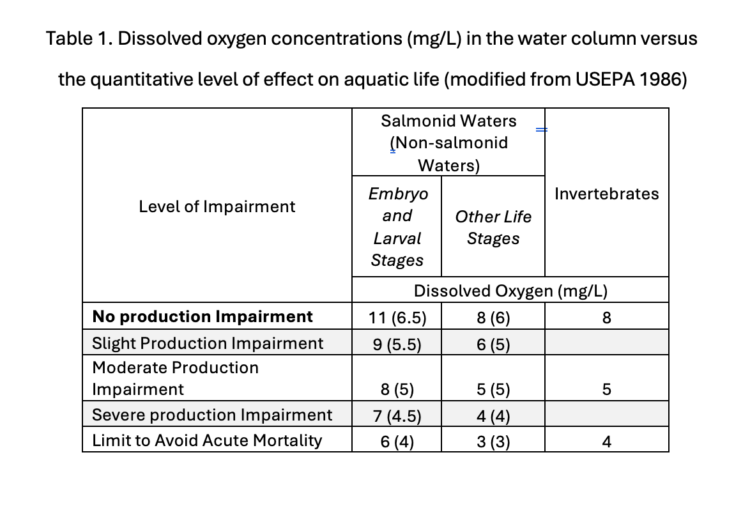



Oxygen is arguably the most important water quality parameter governing overall lake health. It’s required to sustain aquatic life and is directly related to a multitude of water quality parameters and overall aesthetics. The US has national and state dissolved oxygen (DO) criteria for lakes, which are centered around maintaining the minimum amount of DO to sustain life. For example, the US national minimum DO criteria is 5 mg/L, with many states adopting this criterion (USEPA 1986). However, this minimum DO criteria is by no means the desired oxygen level for aquatic life or for overall lake water quality and aesthetics. If we are to assign the desired DO level to a water body, we must first define it based on its effect on a given parameter. Two definitions can be identified based on 1) aquatic life and 2) water quality and aesthetics, which are as follows:
The desired DO, in which there is no production impairment on aquatic life, has been identified by the EPA 1986 publication as 11 mg/L for salmonid waters (cold to cool water fisheries) and 8 mg/L for non-salmonid waters (warm water fisheries; Table 1). While 6.5 mg/L is where no production impairment occurs for non-salmonid water, it does not protect the invertebrates, and therefore 8 mg/L applies as the desired DO for non-salmonid waters. Additional thresholds and corresponding impairment are also presented in Table 1.
The effects of low dissolved oxygen (hypoxia and anoxia) levels have been well documented and negatively affect all stages of aquatic life. The reverse, high dissolved oxygen or hyperoxia, on the other hand, is when oxygen levels go above 100% saturation at temperature and can occur naturally during high rates of photosynthesis, often seen during an algal bloom. Prolonged exposure to hyperoxic conditions can cause oxidative stress, which is when more reactive oxygen species are being produced than what the organism can handle via its antioxidant system. Oxidative stress can be avoided by keeping oxygen levels < 25 mg/L (Colt 2006). Overall, the bulk of the evidence regarding hyperoxia and its impacts on aquatic life suggests it does not negatively impact fish growth or cause impairment (McArley et al. 2021). However, providing elevated DO levels may be beneficial as it can provide metabolic refuge during acute warming. This would reduce fish stress during less-than-ideal temperatures (McArley et al. 2021).
In general, the higher the oxygen level, the better the water quality and aesthetics. This is because a higher oxidative state drives better water chemistry and allows for more oxygen penetration downward into lake sediments, often the primary source of water quality issues in the first place. If we are to keep with the desired oxygen definition, the level at which the maximum reduction in pollutant(s) can be achieved that is not detrimental to aquatic life, then it would be between 15 – 25 mg/L DO, not exceeding 25 mg/L to not cause oxidative stress to aquatic life. This would provide the maximum water quality improvements and reduce/eliminate:
Oxygen Saturation Technology (OSTTM), the next generation aeration system to improve lake/pond water quality, was developed to achieve DO levels identified by the EPA to prevent any production impairments for all species. Check out our FAQ guide here or reach out to our team with any additional questions.

Colt, J. 2006. Water quality requirements for reuse systems. Aquacultural Engineering 34: 143–156.
McArley, T. J., E. Sandblom, and N. A. Herbert. 2021. Fish and hyperoxia—From cardiorespiratory and biochemical adjustments to aquaculture and ecophysiology implications. Fish and Fisheries 22: 324–355.
USEPA. 1986. Quality criteria for water 1986. EPA 440/5-86-001, US Environmental Protection Agency, Washington, DC.
Clarity Resources Group, LLC. All Rights Reserved. Copyright 2024